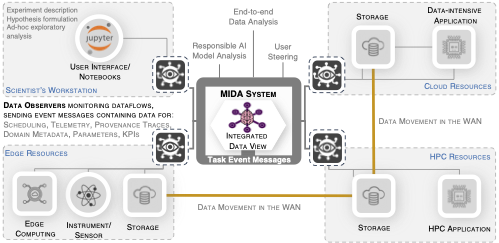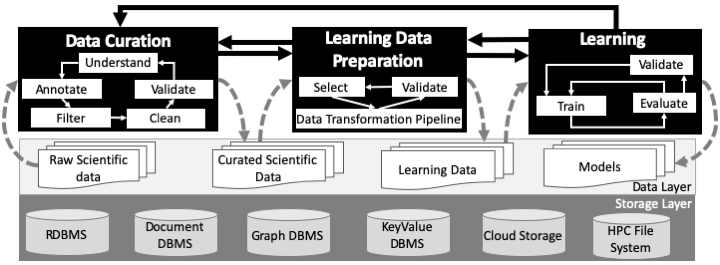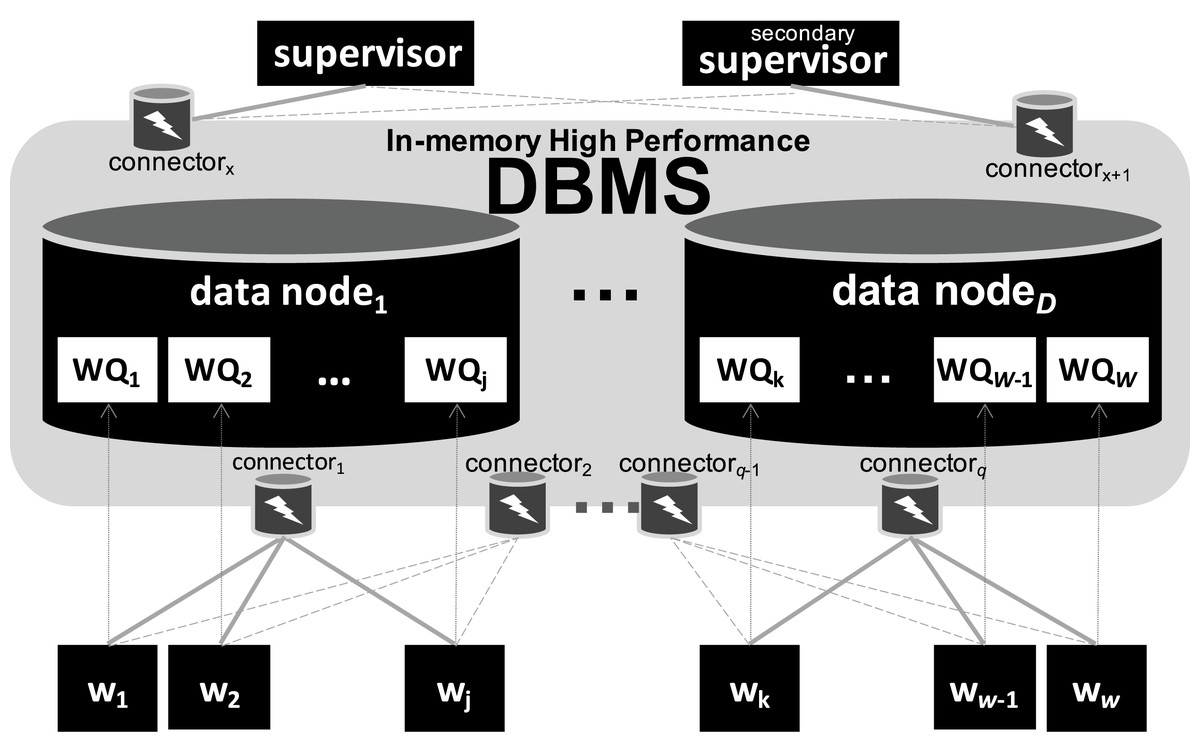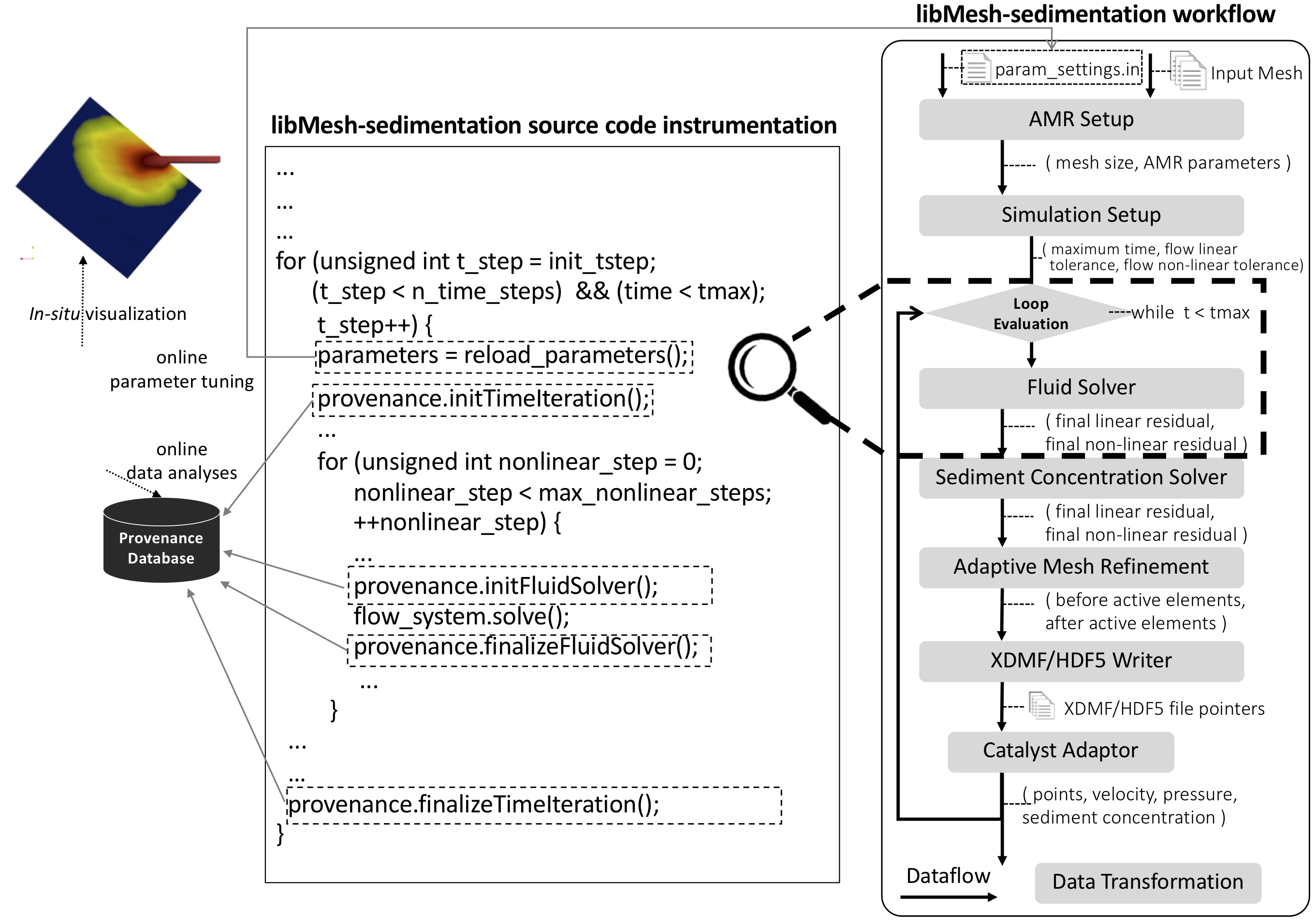Renan Francisco Santos Souza holds a Ph.D., M.Sc., and B.Sc. in Computer Science (2009-2019) from the Federal University of Rio de Janeiro (UFRJ). Since 2022, he has been a staff research scientist at the Oak Ridge National Laboratory. From 2015 to 2022, he worked as a research scientist and software engineer at IBM Research. During his Ph.D., he was a visiting researcher at Inria, France. During his B.Sc., he spent one year at Missouri State University and interned at the SLAC National Laboratory at Stanford University. He has been active as a software engineer, researcher, and technical lead on multiple projects since 2010. He was awarded with the best M.Sc. thesis and an honorable mention for best Ph.D. thesis from SBBD, the leading data science and engineering conference in Latin America. His research and development focus on large-scale data management and AI to support the next generation of Edge–Cloud–HPC workflows.
Large-scale Data Science and Data Engineering •
Edge–Cloud–HPC Workflows •
Provenance Data •
Big Data Analytics •
Machine Learning Systems •
Agentic AI
 |
Towards Lightweight Data Integration using Multi-workflow Provenance and Data Observability
R. Souza, T. Skluzacek, S. Wilkinson, M. Ziatdinov, and R. da Silva
IEEE International Conference on e-Science, 2023.
[1]
[abstract] [doi] [online] [pdf]
[bibtex]
Abstract. Modern large-scale scientific discovery requires multidisciplinary collaboration across diverse computing facilities, including High Performance Computing (HPC) machines and the Edge-to-Cloud continuum. Integrated data analysis plays a crucial role in scientific discovery, especially in the current AI era, by enabling Responsible AI development, FAIR, Reproducibility, and User Steering. However, the heterogeneous nature of science poses challenges such as dealing with multiple supporting tools, cross-facility environments, and efficient HPC execution. Building on data observability, adapter system design, and provenance, we propose MIDA: an approach for lightweight runtime Multi-workflow Integrated Data Analysis. MIDA defines data observability strategies and adaptability methods for various parallel systems and machine learning tools. With observability, it intercepts the dataflows in the background without requiring instrumentation while integrating domain, provenance, and telemetry data at runtime into a unified database ready for user steering queries. We conduct experiments showing end-to-end multi-workflow analysis integrating data from Dask and MLFlow in a real distributed deep learning use case for materials science that runs on multiple environments with up to 276 GPUs in parallel. We show near-zero overhead running up to 100,000 tasks on 1,680 CPU cores on the Summit supercomputer.
@inproceedings{souza2023towards,
abstract = {Modern large-scale scientific discovery requires multidisciplinary collaboration across diverse computing facilities, including High Performance Computing (HPC) machines and the Edge-to-Cloud continuum. Integrated data analysis plays a crucial role in scientific discovery, especially in the current AI era, by enabling Responsible AI development, FAIR, Reproducibility, and User Steering. However, the heterogeneous nature of science poses challenges such as dealing with multiple supporting tools, cross-facility environments, and efficient HPC execution. Building on data observability, adapter system design, and provenance, we propose MIDA: an approach for lightweight runtime Multi-workflow Integrated Data Analysis. MIDA defines data observability strategies and adaptability methods for various parallel systems and machine learning tools. With observability, it intercepts the dataflows in the background without requiring instrumentation while integrating domain, provenance, and telemetry data at runtime into a unified database ready for user steering queries. We conduct experiments showing end-to-end multi-workflow analysis integrating data from Dask and MLFlow in a real distributed deep learning use case for materials science that runs on multiple environments with up to 276 GPUs in parallel. We show near-zero overhead running up to 100,000 tasks on 1,680 CPU cores on the Summit supercomputer.},
author = {Souza, Renan and Skluzacek, Tyler J and Wilkinson, Sean R and Ziatdinov, Maxim and da Silva, Rafael Ferreira},
booktitle = {IEEE International Conference on e-Science},
doi = {10.1109/e-Science58273.2023.10254822},
link = {https://doi.org/10.1109/e-Science58273.2023.10254822},
pdf = {https://arxiv.org/pdf/2308.09004.pdf},
title = {Towards Lightweight Data Integration using Multi-workflow Provenance and Data Observability},
year = {2023}
}
|
 |
Workflow Provenance in the Lifecycle of Scientific Machine Learning
R. Souza, L. G. Azevedo, V. Lourenço, E. Soares, R. Thiago, R. Brandão, D. Civitarese, E. Vital Brazil, M. Moreno, P. Valduriez, M. Mattoso, R. Cerqueira, and M. A. S. Netto
Concurrency and Computation: Practice and Experience, 2021.
[2]
[abstract] [doi] [online] [pdf]
[bibtex]
Abstract. Machine Learning (ML) has already fundamentally changed several businesses. More recently, it has also been profoundly impacting the computational science and engineering domains, like geoscience, climate science, and health science. In these domains, users need to perform comprehensive data analyses combining scientific data and ML models to provide for critical requirements, such as reproducibility, model explainability, and experiment data understanding. However, scientific ML is multidisciplinary, heterogeneous, and affected by the physical constraints of the domain, making such analyses even more challenging. In this work, we leverage workflow provenance techniques to build a holistic view to support the lifecycle of scientific ML.
We contribute with (i) characterization of the lifecycle and taxonomy for data analyses; (ii) design principles to build this view, with a W3C PROV compliant data representation and a reference system architecture; and (iii) lessons learned after an evaluation in an Oil & Gas case using an HPC cluster with 393 nodes and 946 GPUs.
The experiments show that the principles enable queries that integrate domain semantics with ML models while keeping low overhead (<1%), high scalability, and an order of magnitude of query acceleration under certain workloads against without our representation.
@article{asouza2020workflow,
abstract = {Machine Learning (ML) has already fundamentally changed several businesses. More recently, it has also been profoundly impacting the computational science and engineering domains, like geoscience, climate science, and health science. In these domains, users need to perform comprehensive data analyses combining scientific data and ML models to provide for critical requirements, such as reproducibility, model explainability, and experiment data understanding. However, scientific ML is multidisciplinary, heterogeneous, and affected by the physical constraints of the domain, making such analyses even more challenging. In this work, we leverage workflow provenance techniques to build a holistic view to support the lifecycle of scientific ML.
We contribute with (i) characterization of the lifecycle and taxonomy for data analyses; (ii) design principles to build this view, with a W3C PROV compliant data representation and a reference system architecture; and (iii) lessons learned after an evaluation in an Oil \& Gas case using an HPC cluster with 393 nodes and 946 GPUs.
The experiments show that the principles enable queries that integrate domain semantics with ML models while keeping low overhead (<1\%), high scalability, and an order of magnitude of query acceleration under certain workloads against without our representation.},
author = {Souza, Renan and G. Azevedo, Leonardo and Lourenço, Vítor and Soares, Elton and Thiago, Raphael and Brandão, Rafael and Civitarese, Daniel and Vital Brazil, Emilio and Moreno, Marcio and Valduriez, Patrick and Mattoso, Marta and Cerqueira, Renato and A. S. Netto, Marco},
doi = {10.1002/cpe.6544},
journal = {Concurrency and Computation: Practice and Experience},
link = {https://doi.org/10.1002/cpe.6544},
pages = {1--21},
pdf = {https://arxiv.org/pdf/2010.00330.pdf},
title = {Workflow Provenance in the Lifecycle of Scientific Machine Learning},
volume = {e6544},
year = {2021}
}
|
 |
Distributed In-memory Data Management for Workflow Executions
R. Souza, V. Silva, A. Lima, D. Oliveira, P. Valduriez, and M. Mattoso
PeerJ Computer Science, 2021.
[3]
[abstract] [doi] [online] [pdf]
[bibtex]
Abstract. Complex scientific experiments from various domains are typically modeled as workflows and executed on large-scale machines using a Parallel Workflow Management System (WMS). Since such executions usually last for hours or days, some WMSs provide user steering support, i.e., they allow users to run data analyses and, depending on the results, adapt the workflows at runtime. A challenge in the parallel execution control design is to manage workflow data for efficient executions while enabling user steering support. Data access for high scalability is typically transaction-oriented, while for data analysis, it is online analytical-oriented so that managing such hybrid workloads makes the challenge even harder. In this work, we present SchalaDB, an architecture with a set of design principles and techniques based on distributed in-memory data management for efficient workflow execution control and user steering. We propose a distributed data design for scalable workflow task scheduling and high availability driven by a parallel and distributed in-memory DBMS. To evaluate our proposal, we develop d-Chiron, a WMS designed according to SchalaDB’s principles. We carry out an extensive experimental evaluation on an HPC cluster with up to 960 computing cores. Among other analyses, we show that even when running data analyses for user steering, SchalaDB’s overhead is negligible for workloads composed of hundreds of concurrent tasks on shared data. Our results encourage workflow engine developers to follow a parallel and distributed data-oriented approach not only for scheduling and monitoring but also for user steering.
@article{souza_distributed_2021,
abstract = {Complex scientific experiments from various domains are typically modeled as workflows and executed on large-scale machines using a Parallel Workflow Management System (WMS). Since such executions usually last for hours or days, some WMSs provide user steering support, i.e., they allow users to run data analyses and, depending on the results, adapt the workflows at runtime. A challenge in the parallel execution control design is to manage workflow data for efficient executions while enabling user steering support. Data access for high scalability is typically transaction-oriented, while for data analysis, it is online analytical-oriented so that managing such hybrid workloads makes the challenge even harder. In this work, we present SchalaDB, an architecture with a set of design principles and techniques based on distributed in-memory data management for efficient workflow execution control and user steering. We propose a distributed data design for scalable workflow task scheduling and high availability driven by a parallel and distributed in-memory DBMS. To evaluate our proposal, we develop d-Chiron, a WMS designed according to SchalaDB's principles. We carry out an extensive experimental evaluation on an HPC cluster with up to 960 computing cores. Among other analyses, we show that even when running data analyses for user steering, SchalaDB's overhead is negligible for workloads composed of hundreds of concurrent tasks on shared data. Our results encourage workflow engine developers to follow a parallel and distributed data-oriented approach not only for scheduling and monitoring but also for user steering.},
author = {Souza, R. and Silva, V. and Lima, A. A. B. and Oliveira, D. and Valduriez, P. and Mattoso, M.},
doi = {10.7717/peerj-cs.527},
journal = {PeerJ Computer Science},
link = {https://peerj.com/articles/cs-527/},
pages = {1--30},
pdf = {https://arxiv.org/ftp/arxiv/papers/2105/2105.04720.pdf},
title = {Distributed In-memory Data Management for Workflow Executions},
volume = {7},
year = {2021}
}
|
 |
Keeping Track of User Steering Actions in Dynamic Workflows
R. Souza, V. Silva, J. Camata, A. Coutinho, P. Valduriez, and M. Mattoso
Future Generation Computer Systems, 2019.
[4]
[abstract] [doi] [online] [pdf]
[bibtex]
Abstract. In long-lasting scientific workflow executions in HPC machines, computational scientists (the users in this work) often need to fine-tune several workflow parameters. These tunings are done through user steering actions that may significantly improve performance (e.g., reduce execution time) or improve the overall results. However, in executions that last for weeks, users can lose track of what has been adapted if the tunings are not properly registered. In this work, we build on provenance data management to address the problem of tracking online parameter fine-tuning in dynamic workflows steered by users. We propose a lightweight solution to capture and manage provenance of the steering actions online with negligible overhead. The resulting provenance database relates tuning data with data for domain, dataflow provenance, execution, and performance, and is available for analysis at runtime. We show how users may get a detailed view of the execution, providing insights to determine when and how to tune. We discuss the applicability of our solution in different domains and validate its ability to allow for online capture and analyses of parameter fine-tunings in a real workflow in the Oil and Gas industry. In this experiment, the user could determine which tuned parameters influenced simulation accuracy and performance. The observed overhead for keeping track of user steering actions at runtime is less than 1% of total execution time.
Keywords: Dynamic workflows, Computational steering, Provenance data, Parameter tuning
@article{souza_keeping_2019,
abstract = {In long-lasting scientific workflow executions in HPC machines, computational scientists (the users in this work) often need to fine-tune several workflow parameters. These tunings are done through user steering actions that may significantly improve performance (e.g., reduce execution time) or improve the overall results. However, in executions that last for weeks, users can lose track of what has been adapted if the tunings are not properly registered. In this work, we build on provenance data management to address the problem of tracking online parameter fine-tuning in dynamic workflows steered by users. We propose a lightweight solution to capture and manage provenance of the steering actions online with negligible overhead. The resulting provenance database relates tuning data with data for domain, dataflow provenance, execution, and performance, and is available for analysis at runtime. We show how users may get a detailed view of the execution, providing insights to determine when and how to tune. We discuss the applicability of our solution in different domains and validate its ability to allow for online capture and analyses of parameter fine-tunings in a real workflow in the Oil and Gas industry. In this experiment, the user could determine which tuned parameters influenced simulation accuracy and performance. The observed overhead for keeping track of user steering actions at runtime is less than 1\% of total execution time.},
author = {Souza, Renan and Silva, Vítor and Camata, Jose J. and Coutinho, Alvaro L. G. A. and Valduriez, Patrick and Mattoso, Marta},
doi = {10.1016/j.future.2019.05.011},
issn = {0167-739X},
journal = {Future Generation Computer Systems},
keyword = {Dynamic workflows, Computational steering, Provenance data, Parameter tuning},
link = {https://doi.org/10.1016/j.future.2019.05.011},
pages = {624--643},
pdf = {https://hal-lirmm.ccsd.cnrs.fr/lirmm-02127456/document},
title = {Keeping Track of User Steering Actions in Dynamic Workflows},
volume = {99},
year = {2019}
}
|
Last updated on 2025-06-26.
